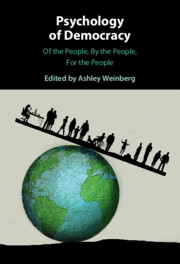Book contents
- Psychology of Democracy
- Psychology of Democracy
- Copyright page
- Contents
- Figures
- Tables
- Contributors
- Preface
- Acknowledgements
- Chapter 1 Psychology of Democracy
- Part I Of the People
- Part II By the People
- Part III For the People
- Chapter 14 Democracy as a Moral Challenge
- Chapter 15 ‘Can I Trust My Future?’
- Chapter 16 Religious Identity Politics and Genuine Support for Democracy
- Chapter 17 Psychology, Democracy and the Media
- Chapter 18 A Social Psychological Approach to Understanding China’s Democratisation
- Chapter 19 The Psychology of Radicalised Conceptions of Democracy
- Index
- References
Chapter 15 - ‘Can I Trust My Future?’
Youth Civic Engagement, Civic Identity and Dystopias
from Part III - For the People
Published online by Cambridge University Press: 24 February 2022
- Psychology of Democracy
- Psychology of Democracy
- Copyright page
- Contents
- Figures
- Tables
- Contributors
- Preface
- Acknowledgements
- Chapter 1 Psychology of Democracy
- Part I Of the People
- Part II By the People
- Part III For the People
- Chapter 14 Democracy as a Moral Challenge
- Chapter 15 ‘Can I Trust My Future?’
- Chapter 16 Religious Identity Politics and Genuine Support for Democracy
- Chapter 17 Psychology, Democracy and the Media
- Chapter 18 A Social Psychological Approach to Understanding China’s Democratisation
- Chapter 19 The Psychology of Radicalised Conceptions of Democracy
- Index
- References
Summary
Democracies provide civic education in order to support young people as they emerge as responsible, well-informed and effective citizens. In this chapter, we critically assess the idea of civic efficacy as it pertains to young people in an era characterised by ongoing economic, political, social and environmental crises, as well as uncertainty, precarity and inequality. Civic education proposes an optimistic, progressive perspective at a time when young people may well be pessimistic about their future prospects and sceptical about the likelihood of positive political change. In this chapter, the authors explore ways in which young people make sense of the future through dystopic and pessimistic imaginaries. Drawing on comparative fieldwork in the UK and Greece to illustrate the concepts, we examine how the social construct of imaginaries can inform our concept of the role young people play in contemporary democracies in crisis. We argue that civic education, and democracy more widely, can empower young people during times of crisis through a new civic approach that accommodates critical – and sceptical – thinking among young people, and supports a wider repertoire of young people’s civic and political action.
- Type
- Chapter
- Information
- Psychology of DemocracyOf the People, By the People, For the People, pp. 332 - 353Publisher: Cambridge University PressPrint publication year: 2022
References
- 1
- Cited by



